Introduction
Tacos de Lengua represent one of Mexico’s most cherished culinary traditions that many food enthusiasts outside the culture have yet to discover. These exceptional tacos, made from perfectly prepared beef tongue, deliver an experience that combines remarkable tenderness with deep, satisfying flavor. For anyone seeking to explore authentic Mexican cuisine beyond the familiar, Tacos de Lengua offer an exciting and rewarding journey.
The magic of Tacos de Lengua lies in the impressive transformation that occurs during cooking. Through patient, slow cooking methods, beef tongue evolves into meat so tender it practically dissolves in your mouth, carrying rich, complex flavors that few other cuts can match. These tacos exemplify resourceful cooking at its finest – creating something extraordinary from an ingredient that many overlook.
Table of Contents
💯 What Makes Tacos de Lengua Special
For those unfamiliar with beef tongue as an ingredient, Tacos de Lengua provide an ideal introduction. When expertly prepared, the meat offers:
✔ Exceptional tenderness that rivals the most expensive cuts
✔ A clean, robust beef flavor with subtle complexity
✔ A satisfying, meaty texture that absorbs seasonings beautifully
✔ Impressive nutritional value, particularly in protein content
✔ An authentic taste of traditional Mexican cuisine
Even those initially hesitant about trying tongue often become enthusiastic converts after experiencing properly prepared Tacos de Lengua. The meat doesn’t announce itself as unusual – instead, it presents as supremely tender beef with a distinctive texture that many find superior to more common cuts.
Essential Ingredients
⭐ The Star Component: Beef Tongue
| Ingredient | Amount | Notes |
|---|---|---|
| Beef tongue | 2-3 pounds | Fresh preferred, but frozen works well when thawed properly |
| White onion | 1 large | Cut into quarters for cooking |
| Garlic | 6-8 cloves | Leave whole with skins on |
| Bay leaves | 2-3 | Dried leaves provide better flavor concentration |
| Whole peppercorns | 1 tablespoon | Black or mixed peppercorns work well |
| Salt | 1-2 tablespoons | Sea salt or kosher salt recommended |
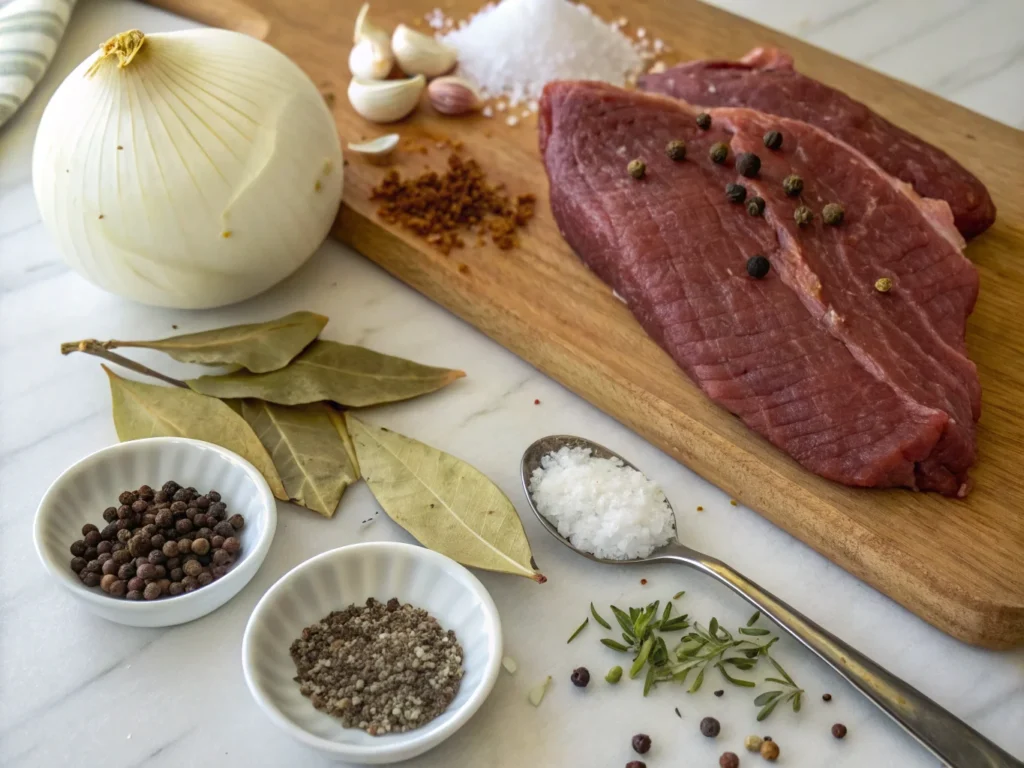
🌟 Essential Taco Assembly Components
| Ingredient | Amount | Notes |
|---|---|---|
| Corn tortillas | 16-20 small | Fresh, 4-5 inch diameter traditional style |
| White onion | 1 small | Finely diced for topping |
| Fresh cilantro | 1 bunch | Chopped, stems removed |
| Lime wedges | 2-3 limes | Cut into small wedges for serving |
| Salsa verde | 1 cup | Fresh tomatillo salsa preferred |
| Avocado | 1-2 | Ripe but firm, sliced or cubed |
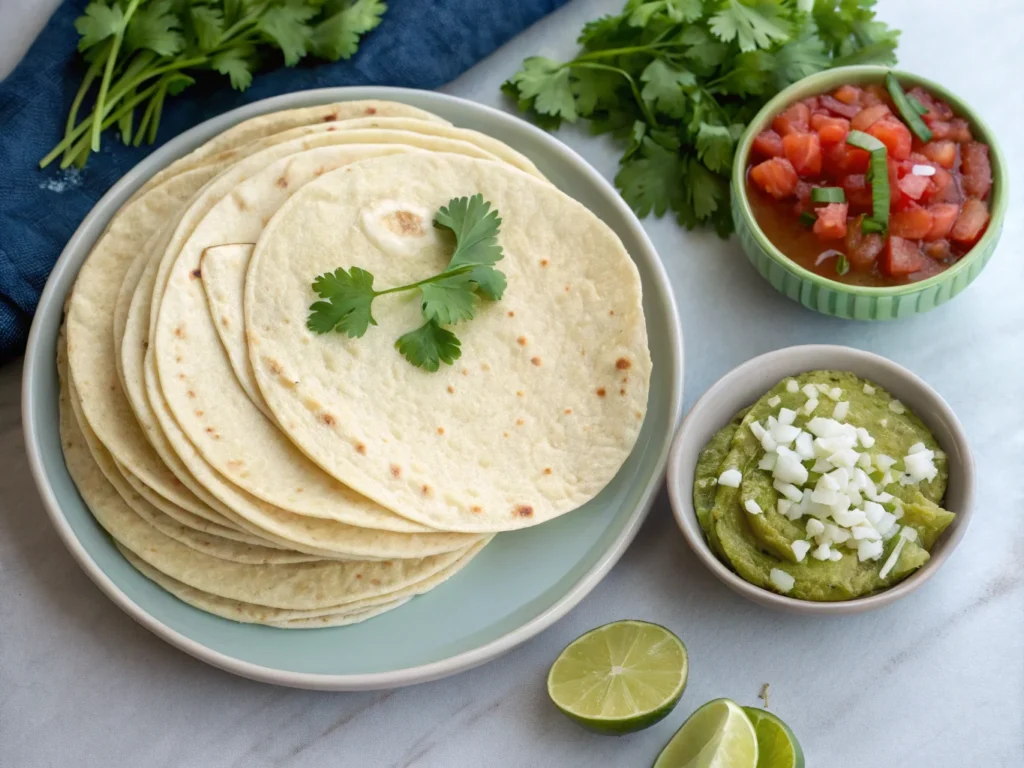
🔄 Possible Ingredient Alternatives for Tacos de Lengua
If you’re not quite ready to work with beef tongue or cannot source it locally, consider these alternatives that can be prepared using similar methods:
✅ Beef cheek meat (cachete) – offers comparable tenderness and rich flavor
✅ Beef brisket – requires similar slow cooking for optimal results
✅ Traditional carnitas (pork shoulder) – different flavor profile but similar application
✅ King oyster mushrooms – can mimic the texture for vegetarian versions
✅ Jackfruit – another plant-based alternative that can absorb similar seasonings
While these alternatives will produce delicious tacos, the unique texture and flavor of properly prepared beef tongue create an experience that’s difficult to replicate exactly.
Tools and Equipment
🔪 Must-Have Kitchen Tools
🔹 Heavy-bottomed stockpot or Dutch oven: Essential for the long, slow cooking process that tenderizes the tongue
🔹 Sharp chef’s knife: Necessary for the important step of peeling and precisely slicing the cooked tongue
🔹 Sturdy cutting board: Preferably with a channel to contain juices during preparation
🔹 Kitchen tongs: For safely handling the hot tongue and manipulating tortillas
🔹 Cast iron skillet or comal: Creates the ideal surface for crisping meat and warming tortillas
🔹 Instant-read meat thermometer: Ensures the tongue reaches the optimal temperature for tenderness
💡 Pro Equipment Tips for Tacos de Lengua
🔸 Consider using a pressure cooker or Instant Pot to reduce cooking time by approximately 60%
🔸 A programmable slow cooker allows for completely hands-off cooking over 8-10 hours
🔸 An authentic comal (traditional Mexican flat griddle) creates the perfect temperature for tortillas
🔸 Heavy, thick-bottomed pans maintain consistent heat and create superior browning on the meat
🔸 A vacuum sealer can help preserve leftover cooked tongue for future meals
Step-by-Step Guide
🧽 Preparation and Cleaning
1️⃣ Thorough initial cleaning: Rinse the beef tongue under cold running water, scrubbing lightly if needed to remove any debris.
2️⃣ Preparation for cooking: Place the cleaned tongue in a large pot that will accommodate it comfortably.
3️⃣ Add cooking liquid: Cover the tongue completely with cold water, allowing about 2 inches of water above the meat.
4️⃣ Incorporate aromatics: Add the quartered onion, whole garlic cloves, bay leaves, peppercorns, and salt to the cooking liquid.
5️⃣ Begin the cooking process: Set heat to high and bring the water to a full boil.
6️⃣ Reduce for simmering: Once boiling, lower the heat to maintain a gentle, consistent simmer.
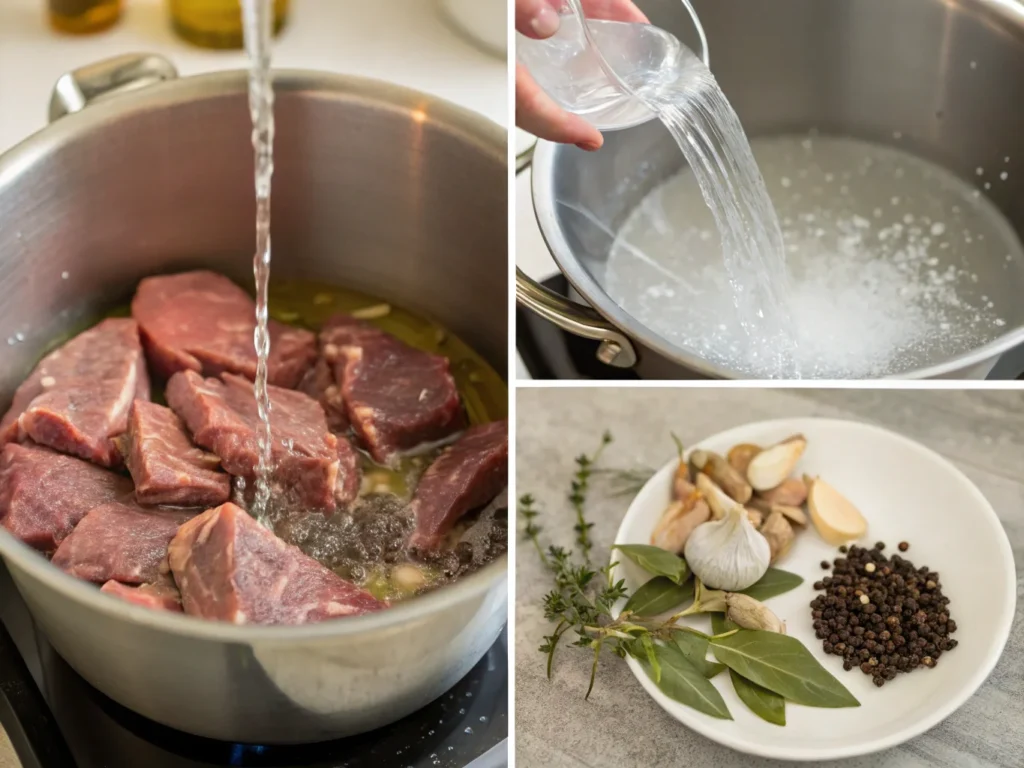
⏱️ The Slow-Cooking Process
1️⃣ Cover and cook: Place a lid on the pot and allow the tongue to simmer gently for 3-4 hours.
2️⃣ Check for doneness: The tongue is ready when a fork easily penetrates the thickest part with little resistance.
3️⃣ Rest before handling: Remove the tongue from the cooking liquid and allow it to cool until you can handle it safely.
5️⃣ Crucial peeling step: Using a sharp knife, carefully remove the outer skin layer that covers the tongue – this will peel away relatively easily when properly cooked.
6️⃣ Precision cutting: Slice the peeled tongue into small, uniform, bite-sized pieces ideal for taco assembly.
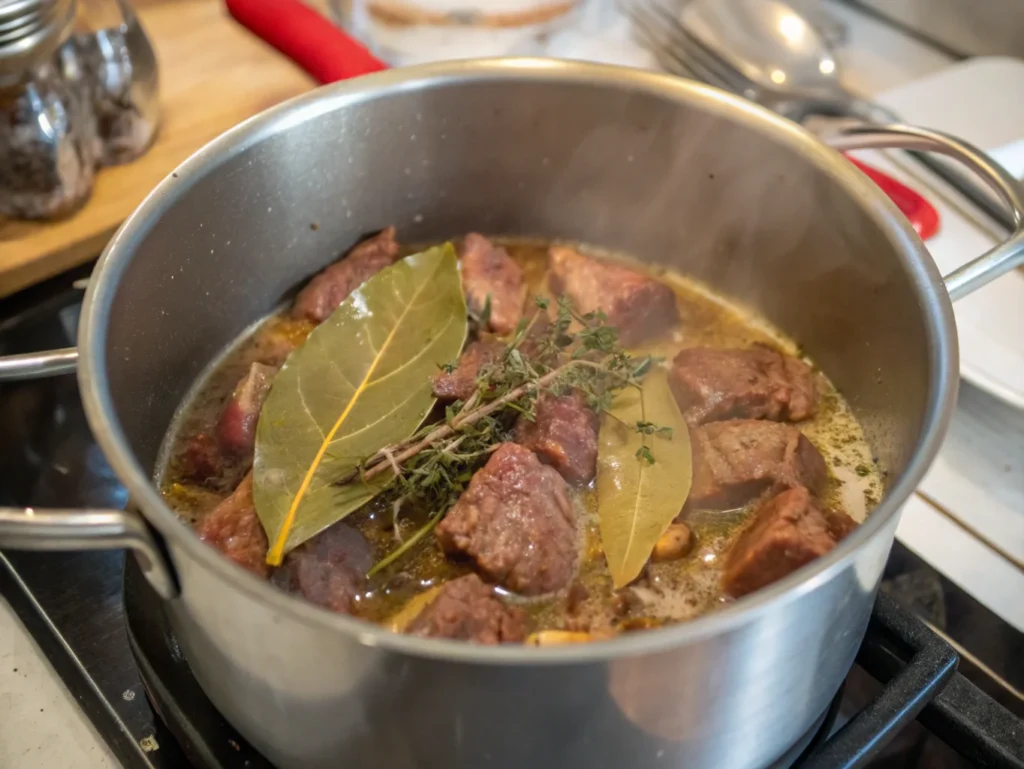
🔥 Perfecting the Meat for Tacos de Lengua
1️⃣ Prepare for crisping: Heat a cast-iron skillet or heavy pan over medium-high heat until hot.
2️⃣ Add cooking fat: Introduce 1-2 tablespoons of oil, lard, or bacon fat to the heated surface.
3️⃣ Crisp in batches: Add sliced tongue pieces in a single layer, being careful not to overcrowd the pan.
4️⃣ Season during cooking: Sprinkle with additional salt and preferred spices to enhance flavor.
5️⃣ Achieve ideal texture: Cook for approximately 2-3 minutes per side until edges develop a golden-brown crispness while maintaining interior tenderness.
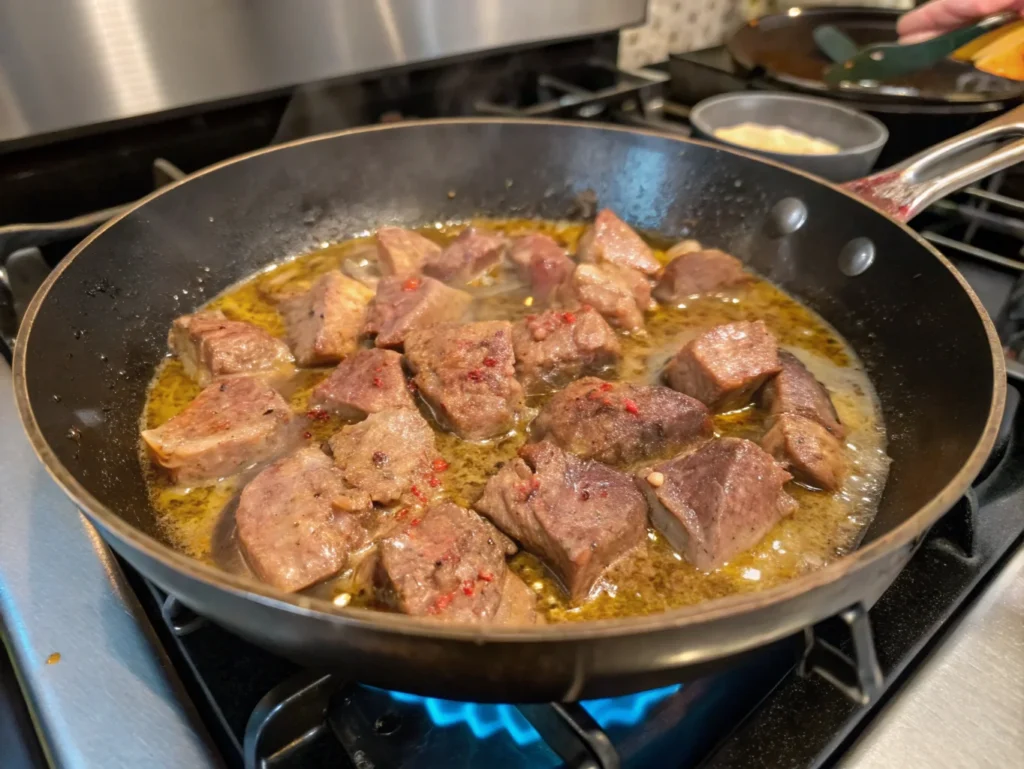
🌯 Creating the Perfect Tacos de Lengua
1️⃣ Prepare tortillas: Heat corn tortillas on a dry skillet or directly over a flame until they become soft, pliable, and slightly charred.
2️⃣ Begin assembly: Place a generous portion of the crisped tongue meat in the center of each warmed tortilla.
3️⃣ Add traditional toppings: Sprinkle with freshly diced white onion and chopped cilantro.
4️⃣ Finish with condiments: Add your preferred salsa verde, a bright squeeze of fresh lime juice, and several slices of ripe avocado.
5️⃣ Serve immediately: Present your Tacos de Lengua while still hot for the optimal dining experience.
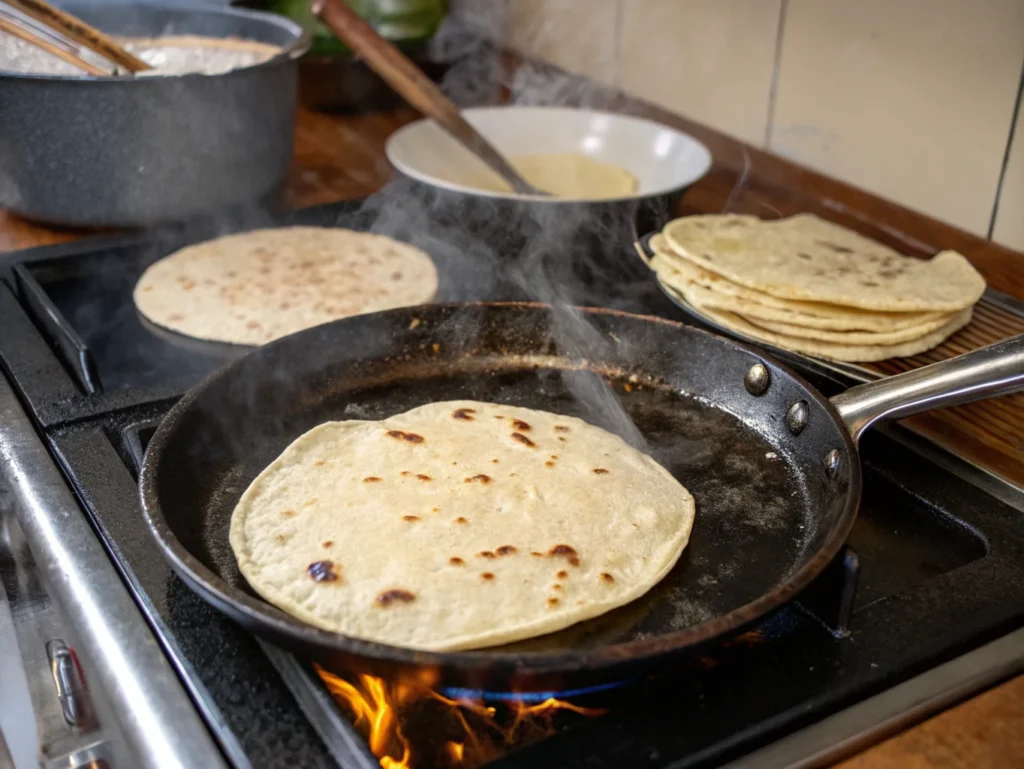
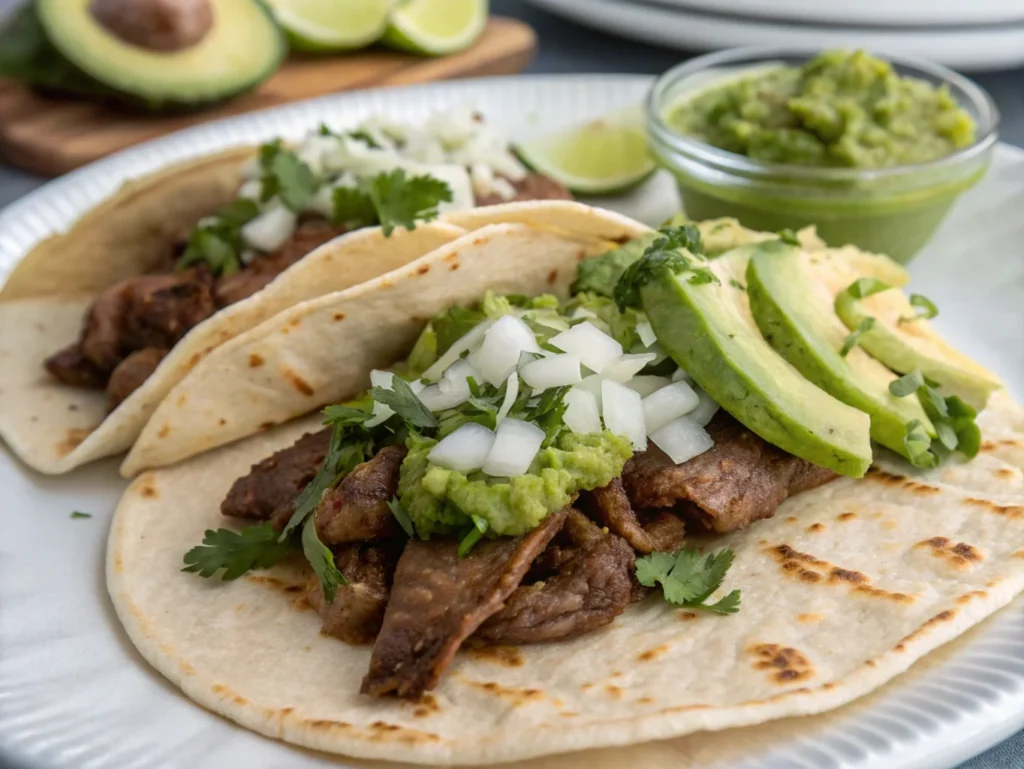
Pro Cooking Tips
💯 Secrets to Perfect Tenderness
● Patience is essential: The transformation of tough tongue to tender meat requires adequate time – never rush this process
● Temperature indicators: Beyond fork tenderness, look for the meat to reach at least 180°F (82°C) internally for ideal texture
● Proper resting period: Allow the cooked tongue to rest for 15-20 minutes before peeling for easier handling and juice retention
● Cutting technique matters: Always slice against the grain of the muscle fibers to maximize tenderness in each bite
● Thickness considerations: Cut the meat thin enough to be tender but thick enough to maintain some texture, approximately ¼-inch slices
⚠️ Avoiding Common Tacos de Lengua Mistakes
● Never skip peeling: The outer layer must be removed after cooking as it has an unpleasantly tough texture
● Portion size is crucial: Excessively large pieces create difficult-to-eat tacos; aim for bite-sized pieces
● Don’t neglect the crisping stage: This critical step develops flavor compounds and textural contrast
● Cold tortillas ruin tacos: Always thoroughly warm corn tortillas for proper flexibility and flavor development
● Overcooking after slicing: When crisping the sliced meat, brief high-heat exposure is sufficient – extended cooking will dry out the meat
Recipe Variations
🇲🇽 Northern Mexico Style Tacos de Lengua
In the northern regions of Mexico, particularly in states like Sonora and Chihuahua, Tacos de Lengua often feature:
● Larger, more substantial pieces of tongue meat
● The addition of crumbled queso fresco or queso cotija
● Accompaniment of charred chile salsa with smoky notes
● Larger flour tortillas in addition to traditional corn options
● Minimal toppings to highlight the quality of the meat
🏙️ Mexico City (CDMX) Style Tacos de Lengua
The bustling capital city has developed its own distinct approach to Tacos de Lengua:
● Very finely chopped tongue meat for quicker service and easier eating
● Double-stacked small corn tortillas for structural support
● An impressive array of salsa options ranging from mild to intensely spicy
● The addition of nopales (cactus paddles) as a traditional topping
● Often served from specialized stands that focus exclusively on offal meats
🌵 Tex-Mex Fusion Tacos de Lengua
Along the border regions and in Tex-Mex establishments, you’ll find these adaptations:
● Option of flour tortillas instead of traditional corn
● Addition of shredded lettuce, diced tomato, and cheese
● Incorporation of creamy, dairy-based sauces rather than traditional salsas
● Accompaniment of refried beans and Mexican rice
● Sometimes served as part of a larger combination plate rather than as street food
🌱 Contemporary Vegetarian “Tacos de Lengua” Alternatives
Creative chefs have developed plant-based interpretations that capture the essence of traditional Tacos de Lengua:
● King oyster mushrooms sliced and scored to mimic the texture of tongue
● Special marinades incorporating traditional tongue-cooking spices and umami elements
● Careful preparation to achieve the characteristic tender-yet-substantial mouthfeel
● Served with all traditional accompaniments for an authentic experience
● Sometimes enhanced with plant-based proteins to more closely match the nutritional profile
Perfect Pairings
🥗 Traditional Side Dishes
Enhance your Tacos de Lengua experience with these classic accompaniments:
● Arroz a la Mexicana – red-tinted rice with vegetables
● Frijoles refritos – smooth refried beans topped with crumbled cheese
● Escabeche – pickled jalapeños, carrots, and onions
● Cebollitas asadas – grilled green onions with lime and salt
● Guacamole – freshly mashed avocado with lime, cilantro, and onion
🥤 Perfect Beverage Pairings
Complement the rich flavors of Tacos de Lengua with these traditional beverages:
● Mexican lager beer served with fresh lime
● Horchata – cinnamon-infused rice milk drink
● Agua de jamaica – tart hibiscus flower tea served cold
● Tamarind agua fresca – sweet-sour tamarind fruit water
● Premium tequila or mezcal for an authentic experience
🌶️ Essential Salsa Selections for Tacos de Lengua
The right salsa can elevate Tacos de Lengua to new heights:
● Classic salsa verde – bright, tangy tomatillo-based green salsa
● Salsa roja asada – smoky roasted tomato and chile salsa
● Pico de gallo – fresh chopped tomato, onion, cilantro, and chile
● Salsa de aguacate – creamy, smooth avocado-based salsa
● Salsa macha – intense oil-based salsa with dried chiles and nuts
Nutritional Information
I’ll convert the nutritional profile paragraph into a clear, organized table:
| Nutrient/Component | Amount/Information | Benefit/Note |
|---|---|---|
| Protein | ~27g per 100g serving | Exceptional content for muscle maintenance and repair |
| Minerals | High levels | Rich source of iron, zinc, and phosphorus |
| B-complex vitamins | Significant amounts | Particularly high in vitamin B12, supporting neurological function |
| Collagen | Contains significant amounts | Potentially beneficial for skin, joint, and digestive health |
| Conjugated linoleic acid (CLA) | Present | May have anti-inflammatory properties |
| Fat content | ~16g per 100g serving | Higher than some leaner cuts; best enjoyed occasionally |
| Dietary recommendation | Occasional consumption | Best within a balanced diet including plant foods, lean proteins, and healthy fats |
This table organizes the nutritional information about Tacos de Lengua in an easy-to-reference format while maintaining all the key details from the original paragraph.
❓ FAQ Section
📦 How should I store leftover beef tongue?
After cooking, beef tongue can be properly stored in several ways:
- Refrigeration: Place cooled, sliced tongue in an airtight container and refrigerate for up to 3-4 days.
- Freezing: For longer storage, wrap sliced tongue tightly in freezer paper or vacuum seal it, then freeze for up to 3 months.
- Storage liquid: Consider storing the tongue in a small amount of its cooking liquid to maintain moisture during refrigeration.
- Reheating: Gently warm refrigerated tongue in a skillet with a small amount of oil to restore its texture and prevent drying.
⏱️ Can I prepare Tacos de Lengua components ahead of time?
Tacos de Lengua are excellent candidates for advance preparation:
- The tongue can be cooked, peeled, and sliced up to 2 days before serving.
- Many chefs believe the flavor of tongue improves after a day in the refrigerator.
- Salsas and toppings can be prepared a day ahead and stored separately.
- Only the final crisping of the meat and warming of tortillas should be done just before serving.
- For a party, consider setting up a Tacos de Lengua bar with the crisped meat in a warming dish and all toppings arranged separately.
🛒 Where can I purchase beef tongue for Tacos de Lengua?
Finding quality beef tongue might require looking beyond traditional supermarkets:
- Dedicated butcher shops often carry beef tongue or can order it upon request.
- Mexican or Latin American markets typically stock beef tongue regularly.
- Farmers’ markets with meat vendors may offer locally raised beef tongue.
- Some supermarkets can special order it through their meat department.
- Online specialty meat retailers deliver beef tongue to your door, often vacuum-sealed and flash-frozen.
🔪 Is removing the outer layer of the tongue absolutely necessary?
The peeling step is not optional when preparing Tacos de Lengua:
- The outer layer has a tough, rubbery texture that significantly detracts from the eating experience.
- After proper cooking, this layer separates relatively easily from the tender meat beneath.
- A sharp knife makes the peeling process much simpler – start at the back of the tongue where the layer is often looser.
- Some cooks find it easier to make a small incision around the edge and then pull the layer back with their fingers.
- If the layer is difficult to remove, the tongue likely needs additional cooking time.
🌡️ How can I tell when the beef tongue is perfectly cooked for Tacos de Lengua?
Several indicators will help you determine when your beef tongue has reached the ideal stage:
- Fork test: The meat should yield easily when pierced with a fork at its thickest point.
- Temperature: An internal temperature of 180-190°F (82-88°C) indicates proper collagen breakdown.
- Visual cues: The tongue will have plumped slightly and may show small splits in the outer layer.
- Timing guidelines: Generally, a 2-3 pound tongue requires 3-4 hours of simmering.
- Touch test: When pressed, the meat should feel tender yet retain some structure.
Conclusion
Tacos de Lengua epitomize the beautiful philosophy at the heart of traditional Mexican cuisine – the transformation of humble ingredients into extraordinary culinary experiences through skill, patience, and deep cultural knowledge. These remarkable tacos offer a gateway to understanding how traditional cooking methods can elevate overlooked ingredients to celebrated status.
The process of preparing Tacos de Lengua connects you to centuries of culinary tradition while delivering incredible flavor and texture that few other dishes can match. The contrast between the tender, rich meat, the fresh brightness of cilantro and lime, the heat of salsa, and the corn flavor of fresh tortillas creates a harmonious balance that exemplifies why Mexican cuisine is celebrated worldwide.
Whether you’re an adventurous eater seeking new culinary horizons, a cook interested in traditional techniques, or simply someone who appreciates extraordinary food, Tacos de Lengua deserve a place in your culinary repertoire. The time and attention they require rewards you with an authentic taste of Mexico’s rich gastronomic heritage and a truly memorable dining experience.
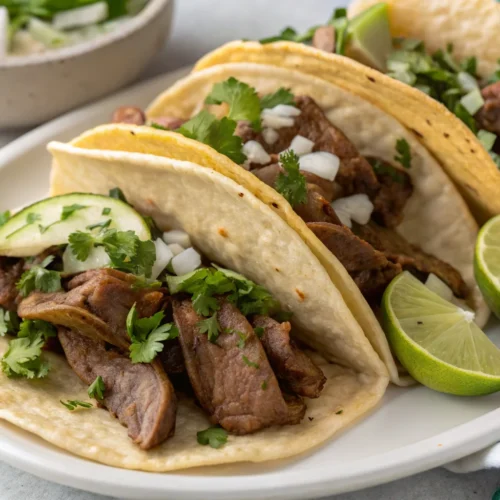
Tacos de Lengua recipe
Ingredients
- Beef tongue 2-3 pounds Fresh preferred but frozen works well when thawed properly
- White onion 1 large Cut into quarters for cooking
- Garlic 6-8 cloves Leave whole with skins on
- Bay leaves 2-3 Dried leaves provide better flavor concentration
- Whole peppercorns 1 tablespoon Black or mixed peppercorns work well
- Salt 1-2 tablespoons Sea salt or kosher salt recommended
- Corn tortillas 16-20 small Fresh 4-5 inch diameter traditional style
- White onion 1 small Finely diced for topping
- Fresh cilantro 1 bunch Chopped stems removed
- Lime wedges 2-3 limes Cut into small wedges for serving
- Salsa verde 1 cup Fresh tomatillo salsa preferred
- Avocado 1-2 Ripe but firm sliced or cubed
Instructions
- Preparation and Cleaning❶ Thorough initial cleaning: Rinse the beef tongue under cold running water, scrubbing lightly if needed to remove any debris.❷ Preparation for cooking: Place the cleaned tongue in a large pot that will accommodate it comfortably.❸ Add cooking liquid: Cover the tongue completely with cold water, allowing about 2 inches of water above the meat.❹ Incorporate aromatics: Add the quartered onion, whole garlic cloves, bay leaves, peppercorns, and salt to the cooking liquid.❺ Begin the cooking process: Set heat to high and bring the water to a full boil.❻ Reduce for simmering: Once boiling, lower the heat to maintain a gentle, consistent simmer.
- The Slow-Cooking Process❶ Cover and cook: Place a lid on the pot and allow the tongue to simmer gently for 3-4 hours.❷ Check for doneness: The tongue is ready when a fork easily penetrates the thickest part with little resistance.❸ Rest before handling: Remove the tongue from the cooking liquid and allow it to cool until you can handle it safely.❹ Crucial peeling step: Using a sharp knife, carefully remove the outer skin layer that covers the tongue – this will peel away relatively easily when properly cooked.❺ Precision cutting: Slice the peeled tongue into small, uniform, bite-sized pieces ideal for taco assembly.
- Perfecting the Meat for Tacos de Lengua❶ Prepare for crisping: Heat a cast-iron skillet or heavy pan over medium-high heat until hot.❷ Add cooking fat: Introduce 1-2 tablespoons of oil, lard, or bacon fat to the heated surface.❸ Crisp in batches: Add sliced tongue pieces in a single layer, being careful not to overcrowd the pan.❹ Season during cooking: Sprinkle with additional salt and preferred spices to enhance flavor.❺ Achieve ideal texture: Cook for approximately 2-3 minutes per side until edges develop a golden-brown crispness while maintaining interior tenderness.
- Creating the Perfect Tacos de Lengua❶ Prepare tortillas: Heat corn tortillas on a dry skillet or directly over a flame until they become soft, pliable, and slightly charred.❷ Begin assembly: Place a generous portion of the crisped tongue meat in the center of each warmed tortilla.❸ Add traditional toppings: Sprinkle with freshly diced white onion and chopped cilantro.❹ Finish with condiments: Add your preferred salsa verde, a bright squeeze of fresh lime juice, and several slices of ripe avocado.❺ Serve immediately: Present your Tacos de Lengua while still hot for the optimal dining experience.
Notes
Nutritional Information
I’ll convert the nutritional profile paragraph into a clear, organized table:| Nutrient/Component | Amount/Information | Benefit/Note |
|---|---|---|
| Protein | ~27g per 100g serving | Exceptional content for muscle maintenance and repair |
| Minerals | High levels | Rich source of iron, zinc, and phosphorus |
| B-complex vitamins | Significant amounts | Particularly high in vitamin B12, supporting neurological function |
| Collagen | Contains significant amounts | Potentially beneficial for skin, joint, and digestive health |
| Conjugated linoleic acid (CLA) | Present | May have anti-inflammatory properties |
| Fat content | ~16g per 100g serving | Higher than some leaner cuts; best enjoyed occasionally |
| Dietary recommendation | Occasional consumption | Best within a balanced diet including plant foods, lean proteins, and healthy fats |
There are no reviews yet. Be the first one to write one.
